by John Markwell
Contributing Editor
This Montana badger was the first taken by the author with the Spartan Precision Rifle’s Walkabout. One 40-gr. Ballistic Tip from the Nosler Custom ammunition did an outstanding job!
The Walkabout, built by Spartan Precision Rifles, was right at home in the varmint fields of Montana.
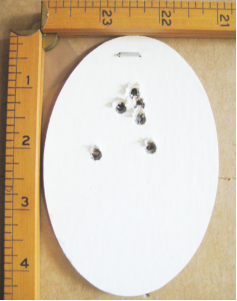
The top three shots in this oval are from 40-gr. Ballistic Tip bullets fired with a normal center hold of the B&C reticle. The 3 lower shots are 55-gr. TSX bullets fired using a center hold on the oval with the B&C reticle’s first hold point. Performance like this is hard to beat. It is the product of some serious experimentation and, the author admits, considerable luck.
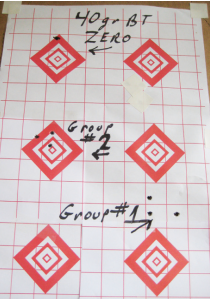
The top left target shows the “dead nuts” zero of the Nosler 40-gr. Ballistic Tip running 3,700+fps. Center right target shows the 55-gr. Barnes TSX bullet’s point of impact to be about 2½-3 inches below the point of aim when using the center crosshair for a hold point. Center left target shows POI of the 55-gr. TSX bullets when using the first hold point of the Leupold B&C reticle to hold “dead on.”
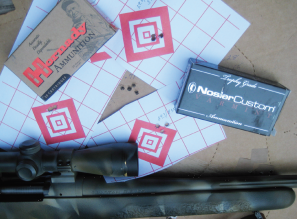
These groups were typical of those fired with both the Nosler Custom and Hornady 40-gr. loads.
***
I’m lucky to live in rifle country. The Allegheny Mountains offer year around opportunities for a rifleman, be it woodchucks during the summer, or the plentiful deer in the Fall/Winter. And then there’s the coyote, which can be pursued all year long, as well as the availability of lots of public land that is open to target shooting.
In light of the above, I have been on pretty much a life-long quest for the perfect, lightweight, everyday rifle capable of tackling most any varmint or game animal available here. Over the years, the majority of the rifles used to fill this niche have been chambered for the .223 Remington cartridge, as is the rifle reviewed here.
Marc Soulie, of Spartan Precision Rifles, assembled a lightweight rifle for me in 2011. With either 40-grain Nosler Ballistic Tip or Hornady 40- grain V-Max factory ammunition it has proven to be almost laser-like on both prairie dogs and gophers. The rifle was just about perfect for rambling around the dog towns and gopher haunts and I had dubbed it the “Walkabout,” with Marc’s approval. The Walkabout’s ”testing” has now encompassed two varmint shooting trips to the Great Plains and 30-plus months of beating around here in the mountains. Keep in mind that this “do all rifle” could be called upon to take on anything from a woodchuck to deer or maybe even a black bear under exceptional circumstances, i.e., surprising one chomping on the neighbor’s sheep. What follows is a review of the Walkabout rifle from Spartan Precision Rifles and an introspective look at my ammunition choices for certain tasks.
The Rifle
I first met Marc Soulie at the Allegheny Sniper Challenge three, or maybe four, years ago. He had come from California to compete in the event and we hit it off right away. We both have an affinity for accurate rifles and 1911 pistols. After spending some time under the generous guidance of the guys at GA Precision, Marc opened the doors of Spartan Precision Rifles in early 2011 and offered to build me a rifle. Marc’s specialty is F-Class and sniper rifles, heavy units, to say the least. Not needing another heavy rifle, I proposed Marc build me a light sporter/varminter in .223 Remington.
I’d provide the parts and Marc would provide the skill and assemble the project. The target weight for the project rifle was 7 pounds.
My plan was to gather the lightest, readily available components I could find for this build. The heart of any rifle is the action. It was also the sticking point on weight reduction as most commercially available actions weigh in at 35 to 40-some ounces. I used a Remington 700 action with a 223 bolt face as a base for this project which weighed in at about 38 ounces without bottom metal.
For a barrel, I went with a Bergara from Spain. Other than seeing a half hour show about the company on outdoor TV one time, I had heard very little of this Spanish barrel company.
Bergara supplies barrels to several major US manufacturers and provides a wide variety of aftermarket barrels as well as gunsmith blanks for custom rifles. Terry Eby fixed me up with a .22 caliber, lightly fluted, stainless steel barrel. It has Bergara Barrel’s #2 contour, is 20 inches in length and measures a mere .575 inch at the muzzle. The twist rate of the barrel is 1 turn in 10 inches. Bergara barrels are all honed after drilling, button rifled and, finally, stress relieved. The factory literature claims they produce “a production barrel that performs like it was custom made.” We would see.
Next I needed a stock for this project.
Manners Composite Stocks is most well known for their tactical rifle stocks but they also manufacture lightweight sporting rifle stocks of carbon fiber reinforced with fiberglass. Weighing 27 to 28 ounces, I chose the MCS-SL (super light) stock without a cut out for floor plate type bottom metal. This rifle was to be of the “ADL” configuration with a blind magazine. The MCS is nicely textured in the grip and forearm areas, has a straight comb, and a cheek piece. My only criticism of the Manners MCS-SL stock is that the bottom of the stock in front of the trigger guard is a bit on the squarish or blocky side. If this section of the stock were of a rounder profile, it would make carrying the rifle at the balance point much more comfortable. Length of pull on my stock was 13¼ inches and the butt was finished off with a Pachmayr Decelerator pad. Sling swivel studs were installed in the forearm and in the pistol grip, as per my request.
The Remington factory trigger was replaced by Marc Soulie with a Timney unit. Although I have had mixed experiences with Timney triggers over the years, this is a great one. In fact, when the finished rifle was received from Marc, the trigger pull was so light; I had to adjust the weight of pull upwards to 2½ lbs! Brownells was my source for the small, weight-saving items that finished off the Walkabout. The Remington steel firing pin and bolt shroud was replaced with a SpeedLock Systems alloy-composite firing pin system. With an aluminum bolt shroud and composite firing pin this unit is less than half the weight of the factory unit and it reduces lock time by 39%.
Since this was to be an ADL style rifle with a blind magazine, I only needed a trigger guard for bottom metal. Again to save weight, I chose an aluminum model from Brownells made by Six Enterprises. Nicely finished, and of a size to accommodate a gloved finger if need be, this unit blended nicely with the bottom of the Manners stock.
It didn’t take Marc long to turn a pile of parts into a pretty neat package of a rifle. I immediately mounted a Leupold VXIII 2.5-8 x 38 telescope with the Boone & Crockett reticle on the rifle, using Tally Lightweight scope mounts.
These mounts/rings were designed by Melvin Forbes of New Ultra-Light Arms here in West Virginia. After giving the rifle a good camouflage paint job, a nicely broken in Brownells 1-inch Latigo sling was attached to complete the project. Then it was off to the local general store down the road to put the completed rifle on the digital produce scale. Fully appointed, and with three rounds of .223 ammunition, the Walkabout from Spartan Precision Rifles weighed in at exactly 7.79 pounds! Not a super featherweight, and a tad over the target weight, the Walkabout turned out pretty light for a project assembled from readily available commercial components.
In preparation for my 2011 western varmint hunt I tested the Spartan Walkabout with an assortment of factory ammunition. The rifle really performed with Nosler Trophy Grade Varmint Ammunition loaded with 40- gr. Ballistic Tip Bullets and Hornady Varmint Express Ammunition with 40-gr. V-Max bullets. Both loads chronographed out of the 20-inch barrel at around 3,700 fps (+ or – a little), grouping 5 shots into less than 3/4 inch, and both loads shot to essentially the same point of aim/ point of impact. I fired approximately 450 rounds of the above ammo through the Spartan Walkabout during May/June 2011 with a very high hit rate. The furry critter count was considerable with a Montana Badger being the big prize bagged with the new Walkabout.
Back in the Mountain State, the Walkabout was used for shooting woodchucks in the late summer of 2011 and quite a few alfalfa munchers fell to the Nosler 40-gr. Ballistic Tip factory load as well as one really nice red fox shot by my son, Brock.
Since I didn’t have an unlimited supply of the Nosler factory 40-Gr. Ballistic Tip load, I started working on an equivalent handload during the winter of 2011/12. Using the Nosler 40- gr. Ballistic Tip bullet, I was not able to equal the velocity of the Nosler factory ammunition with a handload. Loading 28 grains of Hodgdon’s Benchmark behind the 40-gr. BT gave me a velocity of just over 3,600 fps. I can live with that.
During the summer of 2012 the Walkabout again traveled west. The new Nosler Custom Lead Free 40-gr. Ballistic Tip load was used for much of the shooting during that annual summer trip. Performance and POA/ POI was the equal of the traditional BT load and again the furry critter count was high. Our handload also performed well in the field throughout 2012.
Now in its third year of use, the Spartan Walkabout is more than just a varmint rifle to me. It is my current iteration of the “Do All Rifle” and it now resides almost permanently in either my pick-up or the gun rack of my mule. Others have preceded it, but I believe the Walkabout will satisfy me for quite a while. It would be nice if it were a pound lighter but the accuracy the rifle displays day after day, offsets any wishful weight reduction. At 7.79 pounds, and with an overall length of 40 inches, the Walkabout is not a tiny rifle, but, it is svelte and of a size and weight to be conveniently at hand as I go about my daily routines or, even better, take it out for a hike in the hills or hay fields.
Unlike using them on varmints, I know the use of .22 caliber rifles for the taking of larger game animals is quite controversial. It is, however, legal for deer in some states and I feel that with modern bullets and careful shooting, the .223 can be used effectively and humanely. Is it my first choice for a game rifle cartridge? Of course not! But, for a disciplined shooter it will serve. Our family has taken truckloads of varmints and a considerable number of whitetail deer over the years with the .223. For varmints we have used a variety of lightly constructed bullets ranging from 40 to 55 grains in weight; pretty standard fare. Quite a few years back, we handloaded the 70- grain Speer soft point for deer and it did a very good job with careful shooting. When the 60- grain Nosler Partition bullet entered the market, we immediately began using it. We think the Partition bullet’s performance on deer is much better than the old Speer bullet, with through and through penetration on broadside lung shots being pretty much the norm in our experience. When driven to a velocity of 3000+fps in the 223, a well-placed Nosler 60-grain Partition bullet drops whitetails as effectively as many larger cartridges in our considered opinion.
The new Barnes TXS line of bullets, both 55- and 62-grain, also has great possibilities for use in the .223, although I have not tried them on game, yet. I know that Bill Wilson has killed a ton of Texas hogs with TSX bullets in the 6.8SPC and thinks highly of them. I will admit that after living in black bear country for over 40 years I have yet to cap a bear. I do, however, know a lot of houndsmen who have killed lots of the black beasts with an array of cartridges that would make your head spin (and some would make you cringe). If the possibility presented itself, I believe a properly placed 55- or 62-gr. Barnes TSX bullet or 60-gr. Nosler Partition could be pretty effective on all but the largest of our mountain black bears.
Again, this would not be my first choice for this task.
The ultimate goal for the Walkabout, ammunition-wise, has been to find two different loads for two purposes; No. 1: a varmint load with a light frangible bullet that could be placed precisely on small targets at ranges out to about 250 to 275 yards, and No. 2; a “game bullet” load for larger animals that would have a point of impact close enough to that of the varmint load, to make it usable on deer-sized game out to a maximum range of 150 yards. The first load will be the primary load and the one for which the Walkabout is precisely zeroed; i.e., having a point of impact a bit more than one inch above the point of aim. The secondary load, with the heavier bullet, is to be used within 150 yards and needs only to impact within an inch or so of the point of aim at that distance; easily within the vitals of deer-sized game.
The targets shown illustrate the results of some of my load testing with the Walkabout rifle. The varmint bullet of choice, at this time, is the 40-grain Nosler Ballistic Tip load at to 3,600+ fps. As illustrated, this load prints groups in the ½ to ¾ inch range at 100 yards. The field performance of this load has proven to be outstanding and immediate. In almost three years of varminting using this bullet (in both factory and handloaded ammunition) the Walkabout has accounted for a pile of gophers and prairie dogs, several woodchucks, a couple of jack rabbits, and a badger. The Walkabout easily places these bullets with the precision required of a true varmint rifle.
Testing with both the 60-gr. Nosler Partition and the 55 and 62-gr. Barnes TSX bullets has shown the Walkabout has a decided preference for the Barnes 55-gr. TSX. This bullet, loaded to a velocity of 3,150 fps, easily impacts close enough to the POA for the harvesting of whitetails. In fact the point of impact of the 55-gr. TSXs at 100 yards is just about one inch above the first hold point of the Leupold 2.5-8’s Boone & Crockett reticle. (If you’re not familiar with this hold point reticle, check it out on Leupold’s website.) This fortuitous situation allows me to simply use that hold point, instead of the center crosshair, when shooting the 55-gr. TSX load.
As it stands now, my every day varmint load for the .223 Spartan Walkabout has been finalized as a 40-grain Nosler Ballistic Tip Bullet loaded to just over 3,600 fps.
Although I intend to do some more testing, I believe the Barnes 55-gr. TSX will be the bullet of choice for “larger chores”. I intend to find out if the TSX performs as advertised soon, as crop damage permits for deer should have been handed out by the time this goes to press. At this time I’m just as pleased as can be with the Spartan Walkabout rifle’s “do all” potential. The rifle performs exceptionally well with two different, missionspecific loads each of which requires nothing more than the simple use of a different reticle hold point to effectively put shots on target. As my use of the Walkabout heads towards the three year mark, testing of new bullets will continue as they come to our attention.
The selection and use of proper bullets for varying tasks is the key to the Walkabout’s versatility as a “do-all” rifle. So far, the concept has proven successful and yet, testing will continue.
Now, if I could figure out how to get the Walkabout to shed just one pound. Good shooting!

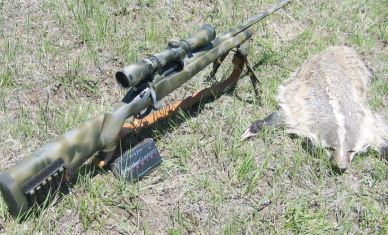
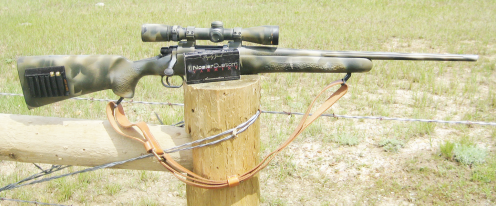




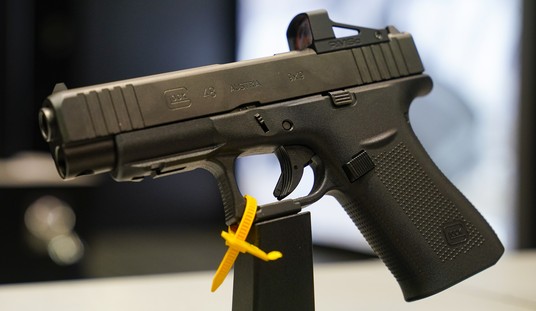
Join the conversation as a VIP Member